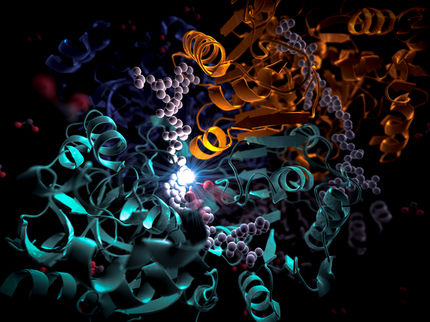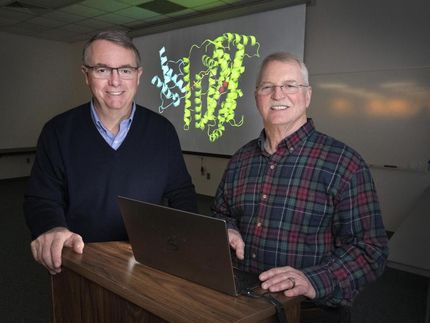New green chemistry extracts valuable compounds from plant waste
Around 98 per cent of lignin created as a forestry by-product from plants is discarded, but a new enzyme could be the key to extracting high-value molecules from this waste using a green chemistry approach.

The newly identified enzyme highlighted in pink.
University of Adelaide
These molecules are the building blocks for compounds like fragrances, flavourings, fuels and therapeutics, turning a waste stream into a valuable resource.
“Traditional chemical processes for synthesis of these types of chemicals rely on petroleum-based starting compounds and heavy metal catalysts, making them non-renewable and inherently toxic processes,” says Dr Fiona Whelan, a Cryo-electron Microscopist from Adelaide Microscopy at the University of Adelaide, whose study was published in Nature Communications.
“This new catalytic processing method will support development of other new green chemistry ‘enzyme factories’ or biorefineries to turn the lignin and other biological waste streams into a valuable repository of fine chemicals.”
Lignin is the name given to the hard polymers that act as mechanical support in hard- and softwoods and is one of the most abundant polymers on Earth.
Agriculture and forestry amass around 100 million tonnes of waste lignin per year, but this could be diverted to become a promising renewable and sustainable feedstock for chemicals currently obtained from fossil fuels.
“Strategies for using lignin involve a combination of chemical and biological processes,” says Associate Professor Stephen Bell, from the University’s School of Physics, Chemistry and Earth Sciences.
“High temperatures, high pressure, strong acids and poisonous solvents are used to break up the polymers in the waste stream.
“The valuable compounds trapped in the waste are then extracted and undergo further chemical processing at temperatures higher than 400°C to ‘valorise’ the lignin. These processes are expensive and bad for the environment.”
Hardwood lignin has two key chemical components that require processing to make useful compounds.
Researchers had previously discovered an enzyme that could be used to break down one of these compounds, which is also found in softwood, but no biological breakdown process had been identified that could use the second more complex hardwood compound, comprising about 50 per cent of the waste.
“Biological breakdown of lignin occurs in a complex microbial quorum, with fungal enzymes likely breaking up hard polymers, and bacteria taking the unreactive smaller compounds and processing them to get metabolic energy,” said Dr Whelan.
“Looking to the microbial kingdom, we identified that a soil bacterium, Amycolatopsis thermoflava, contains enzymes that could process molecules from lignin cheaply, using hydrogen peroxide to drive the reaction – making valorisation much less harmful to the environment.”
The research team has used this new enzyme as a model for retrofitting the hydrogen peroxide driven activity into other enzymes to generate green chemistry approaches of the future for the generation of high value chemicals of use in the flavour, fragrance and medicinal chemistry industries.
Original publication
Other news from the department science

Get the chemical industry in your inbox
By submitting this form you agree that LUMITOS AG will send you the newsletter(s) selected above by email. Your data will not be passed on to third parties. Your data will be stored and processed in accordance with our data protection regulations. LUMITOS may contact you by email for the purpose of advertising or market and opinion surveys. You can revoke your consent at any time without giving reasons to LUMITOS AG, Ernst-Augustin-Str. 2, 12489 Berlin, Germany or by e-mail at revoke@lumitos.com with effect for the future. In addition, each email contains a link to unsubscribe from the corresponding newsletter.


























































